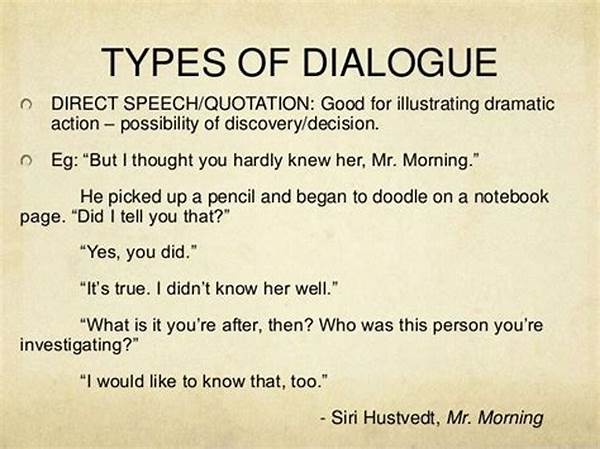When it comes to storytelling, dialogue plays a critical role in bringing characters to life and moving the plot forward. The way characters speak to one another can reveal their personalities, build tension, and even suggest underlying themes in the story. By exploring varied dialogue styles in writing, authors can enhance the depth and authenticity of their narratives. Let’s delve into the fascinating world of dialogue and discover how different styles impact storytelling.
Exploring Varied Dialogue Styles
Varied dialogue styles in writing allow authors to capture the unique voices of their characters and create more engaging stories. Some writers use realistic, everyday conversations to make their characters relatable, while others might opt for more stylized, poetic exchanges to add a layer of sophistication. By employing different dialogue styles, writers can craft stories that resonate with diverse audiences and bring their characters to life in distinctive ways.
In some genres, such as comedy, dialogue might be witty and fast-paced to keep the audience entertained and the plot moving briskly. Conversely, in dramas, authors might use a more measured and solemn dialogue style to underscore the seriousness of the themes being explored. Through dialogue, writers can effectively convey the mood and tone of their stories, ultimately shaping the reader’s perception and emotional response.
Experimenting with varied dialogue styles in writing also helps in world-building, particularly in fantasy and science fiction genres. By adapting the dialogue to fit the cultural and societal norms of the story’s setting, authors can create immersive worlds that feel authentic and believable. This careful crafting of dialogue not only enriches the narrative but also enhances the reader’s experience.
Understanding Dialogue Styles
1. Varied dialogue styles in writing help authors define the personality and background of their characters, providing depth and authenticity.
2. Using different dialogue styles can enhance the mood and tone of the story, contributing to the overall narrative arc.
3. Dialogue can serve as a tool for exposition, conveying essential information without overtly stating it.
4. Varied dialogue styles in writing allow for dynamic character interactions, revealing relationships and tensions.
5. Experimenting with dialogue styles can help in effectively establishing the setting and culture of the story’s world.
The Art of Crafting Dialogue
In crafting dialogue, the choice of style can make or break the reader’s engagement with the story. Natural sounding language, for instance, plays a significant role in crafting authentic dialogue. To achieve this, writers often spend time listening to real conversations and observing how people interact in different contexts. This attention to detail helps in writing dialogue that feels genuine, as if the characters are conversing in the reader’s world.
Varied dialogue styles in writing provide an opportunity for authors to experiment and find the right voice for their story. Whether it’s the sophisticated banter seen in classic literature or the colloquial exchanges in modern novels, each style serves a purpose. By understanding the nuances of different dialogue styles, writers are better equipped to select the one that best aligns with their narrative, enhancing both character development and storytelling.
Benefits of Natural Sounding Dialogue
1. Natural sounding dialogue creates characters who appear more relatable and realistic to the reader.
2. It captures the reader’s attention by presenting conversations that mirror everyday interactions.
3. Such dialogue facilitates smoother narrative flow, making the story more immersive.
4. It helps convey emotions authentically, drawing readers into the characters’ experiences.
5. Writing dialogue that feels natural enhances character dynamics, enriching the story’s depth.
6. The use of natural dialogue underscores the mood and tone effectively, complementing varied dialogue styles in writing.
7. Natural dialogue can make complex themes more accessible, enabling a deep connection with the reader.
8. Dialogue that sounds real helps in establishing the setting of the story, contributing to the world-building process.
9. It aids in maintaining the reader’s suspension of disbelief by avoiding jarring or out-of-place exchanges.
10. Natural sounding dialogue supports stronger narrative pacing, keeping the story engaging and focused.
Varied Dialogue Styles in Writing: Summary
Crafting dialogue is a nuanced art that requires an understanding of how different styles impact storytelling. By exploring varied dialogue styles in writing, authors can create unique voices for their characters and build richer narratives. Whether it’s through natural sounding language or more stylized forms, dialogue remains a cornerstone in developing engaging and believable stories.
Ultimately, the key to mastering dialogue lies in experimentation and finding the right balance that complements the story. Writers who are adept at utilizing varied dialogue styles can effectively convey emotions, advance the plot, and provide readers with an immersive experience. As dialogue shapes the dynamics within stories, its influence on character development and world-building cannot be understated.
